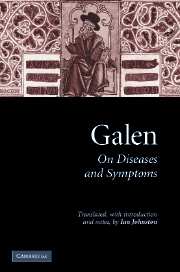Book contents
- Frontmatter
- Contents
- List of tables
- Acknowledgements
- List of abbreviations
- PART I INTRODUCTION
- PART II TRANSLATION
- II.0 Introduction
- II.1 On the Differentiae of Diseases
- II.2 On the Causes of Diseases
- II.3 On the Differentiae of Symptoms
- II.4 On the Causes of Symptoms I
- II.5 On the Causes of Symptoms II
- II.6 On the Causes of Symptoms III
- PART III CONCLUSION
- Bibliography
- Index
II.1 - On the Differentiae of Diseases
Published online by Cambridge University Press: 22 September 2009
- Frontmatter
- Contents
- List of tables
- Acknowledgements
- List of abbreviations
- PART I INTRODUCTION
- PART II TRANSLATION
- II.0 Introduction
- II.1 On the Differentiae of Diseases
- II.2 On the Causes of Diseases
- II.3 On the Differentiae of Symptoms
- II.4 On the Causes of Symptoms I
- II.5 On the Causes of Symptoms II
- II.6 On the Causes of Symptoms III
- PART III CONCLUSION
- Bibliography
- Index
Summary
SYNOPSIS
I.1 Outlines the objectives in this book: to define health and disease and to enumerate in full all ‘simple and primary diseases’ and the combined diseases arising from these.
II.1 Initial definitions of health and disease in both structural (kataskeue) and functional (energeia) terms. Introduction of the terms kata phusin and para phusin – in accord and not in accord with nature.
II.2 Health and disease identified as ‘balance’ (summetros) and ‘imbalance’ (ametros) respectively.
II.3 The issue of what is or is not in balance is raised. Galen recognizes two possible structural concepts: (i) poroi and anarmoi; and (ii) the four ‘qualities’.
II.4 Discussion of the difficulties of accounting for degrees of health or disease (‘more or less’) on the basis of impassible, immutable elements.
III.1 Galen's scheme of three levels of structure: (i) homoiomeres, e.g. arteries, bones etc.; (ii) organs, e.g. heart, lungs etc.; (iii) the whole body.
IV.1 Diseases of homoiomeres on the poroi/anarmoi hypothesis are two in kind: an imbalance due either to an excess of constriction, or to an excess of dilatation. Two additional states are described: an imbalance in either direction not yet sufficient to constitute disease (i.e. harm function), and an extreme imbalance causing destruction of the part.
IV.2 On the basis of the hypothesis of elements/qualities which Galen favours, there are four primary diseases consisting of imbalances involving heat, cold, dryness and moisture respectively.
IV.3 Diseases of compound structures (organs) are common to both hypotheses and comprise four classes:
1. Formation: destruction or disturbance of normal form; acquisition or loss of a cavity or channel; abnormal roughness or smoothness.[…]
- Type
- Chapter
- Information
- Galen: On Diseases and Symptoms , pp. 131 - 156Publisher: Cambridge University PressPrint publication year: 2006



